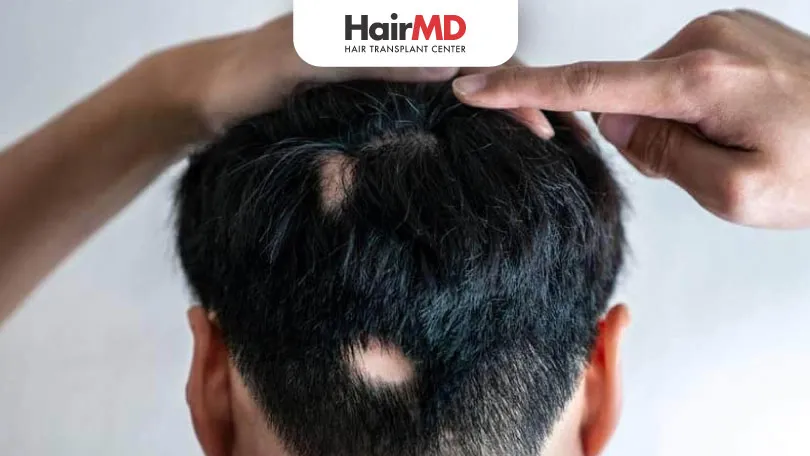25th August, 2021

Alopecia areata is a common autoimmune disorder that causes unpredictable patchy hair loss; however, in some cases, it can lead to complete hair loss. Alopecia areata isn’t age or gender-specific. It can happen to anyone from any age group, although most cases are less than 30 years old.
In many situations, hair regrows across the bald patches within a few months. However, how do you know if your hair is growing back from Alopecia? What are the common alopecia areata regrowth signs and alopecia areata regrowth stages? Let’s learn about them in this blog.
What’s covered in the article?
- Causes of Alopecia Areata and Risk Factors
- Alopecia Areata Regrowth Signs | Alopecia Areata Regrowth Stages
- How Long Does Alopecia Take to Regrow?
- Treat Alopecia Areata with HairMD
- Conclusion
Causes of Alopecia Areata and Risk Factors
What is the cause of alopecia areata? The condition occurs when the body’s immune system accidentally attacks the hair follicles for some unknown reason. But the good news is that the follicles retain their ability to regrow hair, and in most people, the hair loss is only temporary.
However, in some cases, alopecia areata is accompanied by thyroiditis, vitiligo, and pernicious anemia. 18% to 20% of patients suffer from alopecia areata due to hereditary causes. Accordingly, experts have an understanding that the condition has a genetic predisposition. People with close relatives who’ve suffered from alopecia areata are at a higher risk of developing the condition, especially if the family member has suffered from the condition before the age of 30.
Alopecia Areata Regrowth Signs | Alopecia Areata Regrowth Stages
Let’s now look at the various regrowth stages of alopecia areata. We’ll also see how alopecia areata affects an individual to varying extents and features various occurrences.
As stated earlier, hair regrows on the bald patch within a few months due to the follicles’ ability to regrow hair. Regrown hair may not have its usual color and look gray or white initially. However, the hair would regain its original color after many months.
In some cases, single or multiple bald patches may develop a few weeks after the first. In fact, some people may experience regrowth on some patches and, at the same time, see new patches developing across other regions of the scalp.
Sometimes, small patches may merge to form a large bald patch. Rarely do some people lose all their scalp hair. A few also lose eyelashes, eyebrows, body hair, beard, etc. Some people have reported pitting or removing the nails, although such cases are also rare.
How Long Does Alopecia Take to Regrow?
While one cannot commit to a particular timeframe for hair regrowth, it may take a few to several weeks for the hair to regrow in alopecia areata. In some people, as we’ve seen above, hair regrowth in bald patches and the development of new bald patches could be simultaneous. Nevertheless, corticosteroids may help regrow hair in around seven to eight weeks. On the other hand, minoxidil may help regrow hair in about 11-12 weeks. Although yes, the treatment isn’t suitable for extreme cases or total hair loss.
Furthermore, the regrowth period can vary from person to person and would depend on the individual’s response to a particular treatment. Consulting a dermatologist to get case-specific information can help.
Treat Alopecia Areata with HairMD
At HairMD, we are a team of experienced dermatologists who’ve helped many people treat Alopecia Areata through various treatmentsOur dermatologists ensure appropriate diagnosis and proper treatment and respond to all your questions with the best possible answers concerning Alopecia Areata, early-stage Alopecia Areata regrowth signs, and alopecia areata treatments, etc. to help clear your doubts.
Do You Know?
Nearly 250 Patients Visit HairMD
Everyday For Various Hair Concerns?
(Your journey to healthier and fuller hair starts here!)
Meet Our Dermatologists
Conclusion
In conclusion, while alopecia areata can cause unpredictable hair loss, there is hope for regrowth. Understanding the signs and stages of hair recovery helps manage expectations and encourages patience. Treatments such as corticosteroids and minoxidil can aid in the process, but regrowth timelines vary among individuals. With expert guidance and proper care, many people experience positive outcomes.
Further Reading
How to Treat Alopecia Areata at Home: Natural Solutions for Hair Growth
Explore home remedies for alopecia areata to promote hair regrowth and boost confidence from home.
What Is The Best Treatment For Alopecia Universalis?
Learn about the best treatments for alopecia universalis, a condition causing total hair loss. Explore expert-recommended therapies and options for hair regrowth at HairMD.
Alopecia Care: Advanced Treatment Options for Men and Women
Explore alopecia treatments for men and women: minoxidil, laser therapy, and expert consultations in Pune. Find effective solutions!
When Does Alopecia Areata Typically Begin? Key Age Insights
Alopecia areata can start at any age, but often begins in teens, twenties, or thirties. Learn more about its onset and impact
Have thoughts? Please let us know
We are committed not only to treating you, but also educating you.











